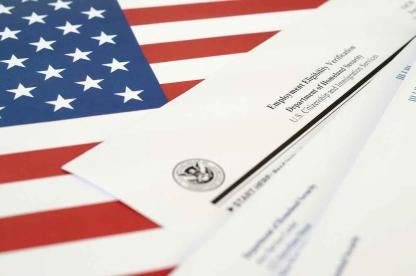Employers take note: most of you will need to take significant action to update and/or correct your Form I-9, Employment Eligibility Verification, in the coming weeks due to sunsetting temporary COVID-19 flexibilities relating to physical inspection of employee documents. Failure to take timely action could result in significant monetary and other penalties.
The Department of Homeland Security (DHS) recently announced that its COVID-19 “flexibilities” relating to physical inspection of identity and employment eligibility documents, temporarily permitting remote and virtual review of such documents will be coming to an end as of July 31, 2023. Employers must ensure they complete physical inspection of any such documents and update their I-9s no later than August 30, 2023.
Before we explain what exactly employers need to do to comply, let’s first take a step back and clarify a few things about remote hires and the I-9 process. Prior to the onset of COVID, many employers encountered challenges properly executing I-9 verification for remotely hired employees who could not report to a company location for onboarding. I-9 rules have always required physical inspection of identity and employment eligibility documents in conjunction with the employer’s completion of its portion (Section 2) of the I-9 form – even for remote hires. This must take place on or before the 3rd day of employment. Therefore, for remote hires employers must engage an agent or authorized representative to inspect the documents and complete the I-9 on their behalf. The authorized agent or representative can be anyone (e.g., spouse, roommate, neighbor, etc.) who is not the employee, but employers are responsible for reviewing the agent’s work and ensuring the use of an authorized representative complies with all state and federal laws.
COVID-19 Meets Form I-9
During the COVID-19 pandemic, DHS temporarily relaxed an employer’s obligation to physically inspect employees’ original identity and employment authorization documents, temporarily allowing inspection of virtual or copied documents. Here’s the kicker: these special rules did not apply to remote hires! They were specifically designed for hired employees temporarily displaced from the workplace due to COVID. Furthermore, in-person verification was still required for all hires physically reporting to any workplace operating during the pandemic.
The flexibility was extended and/or modified multiple times, but always with the expectation that physical inspection of every employee’s original documents would be required once the temporary provisions expired or upon the employee’s returned to the workplace.
Employer Obligations and Best Practices
Per DHS guidelines, every employer must complete in-person physical document inspection of identity and employment eligibility documents virtually (or remotely) reviewed during the duration of the COVID-19 flexibilities program, from March 20, 2020 to July 31, 2023. The physical inspection must be completed and the corresponding Forms I-9 must be annotated (see below) no later than August 30, 2023. For employers with high turnover, that may mean reviewing documents for the majority of their current employees.
Here are several best practices to follow:
- Employers should create a clear employee roster and compare it to all existing I-9s. The roster should delineate those employees, hired after March 20, 2020, whose documents were inspected remotely and a plan of action should be implemented soon to ensure all such employee’s original documents are inspected in-person before the end of August. Summer vacations will slow review in coming months, so the process should begin soon. If any unrelated errors or omissions are discovered on employees’ Form I-9s, they should be corrected following USCIS guidelines.
- Original documents are required (with rare exceptions for printed I-94s and other outliers) and must be presented in-person by the employee.
- Employers must update the Form I-9 in Section 2 or Section 3 (for reverification), as necessary, by listing the date of the physical inspection and annotating “documents physically examined.” For further details and examples, see USCIS guidance, Form I-9 Examples Related to Temporary COVID-19 Policies.
- If remote employees work far from employer worksites, employers may use an authorized representative to review the documents in-person on behalf of the employer and update the Form I-9. As explained above, the authorized representative can normally be anyone who is not the employee, but employers are responsible for reviewing their work and ensuring the use of an authorized representative complies with all state and federal laws.
- If the employer representative who remotely reviewed the original I-9 documents is not available to perform the in-person review of original documents, a different representative can annotate the “Additional Information” box, on page 2 of the I-9, or complete a new Form I-9 Section 2 and attach it to the prior remotely inspected Form I-9.
- If the employee has since separated from employment, a simple annotation in their Form I-9 “Additional Information” box, including the date of separation, will suffice. There is no need to track down a former employee to review their original documents.
- Remotely inspected documents that have since expired can still be reviewed in-person (i.e., US passport, green card, driver’s license or state ID) and new documents should not be requested. However, employers must not rely on a now expired document that would have required reverification to prove ongoing work authorization (i.e., EAD or I-94). The employee will need to present a valid List A or List C work authorization document at the time of physical inspection.
- An employee who was run through the E-Verify process when they were hired under the I-9 COVID-19 flexibilities provisions will still require the standard in-person inspection of original documents outlined above, but employers should not create a new E-Verify case nor update the employee’s existing E-Verify case relating to the physical inspection of their documents.
USCIS has provided an in-depth Q&A resource that discussed most common situations. Nevertheless, myriad potential questions may arise based on each employee’s facts, so employers should follow government guidance and seek counsel from an experienced immigration attorney to ensure compliance with the law.
Is There a Fix for Remote Employees?
Well, maybe. The DHS previously sought public comment on the establishment of a pilot program incorporating virtual (or remote) inspection of I-9 documents. This could be the “fix” for the remote hire dilemma, but nothing is in “black and white” yet. DHS will still need to implement formal rulemaking procedures and may also include mandatory E-Verify registration for employers seeking to participate in such a program.
Also, keep a watch out for the release of a new version of the Form I-9. The exact release date is not yet known. The proposed changes will likely compress the form into one page from two and move Section 3 to a separate Reverification and Rehire Supplement.





 i
i


